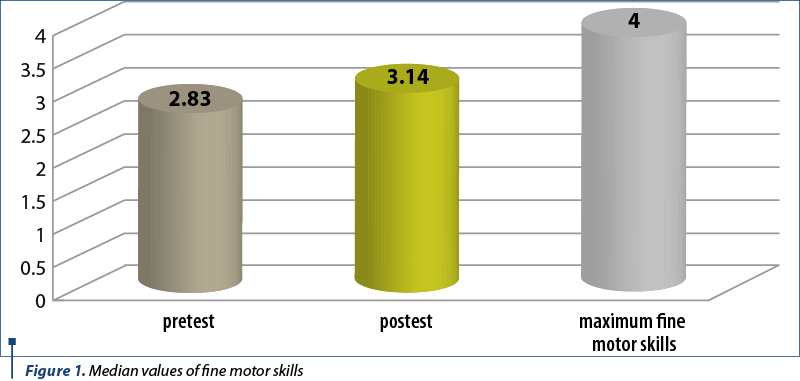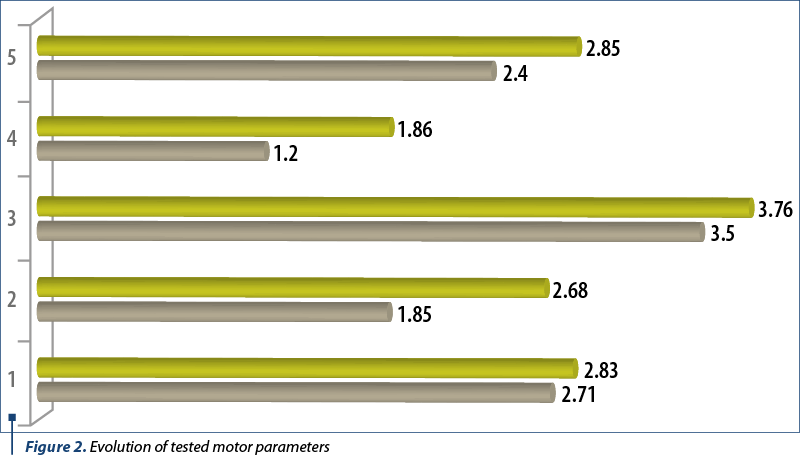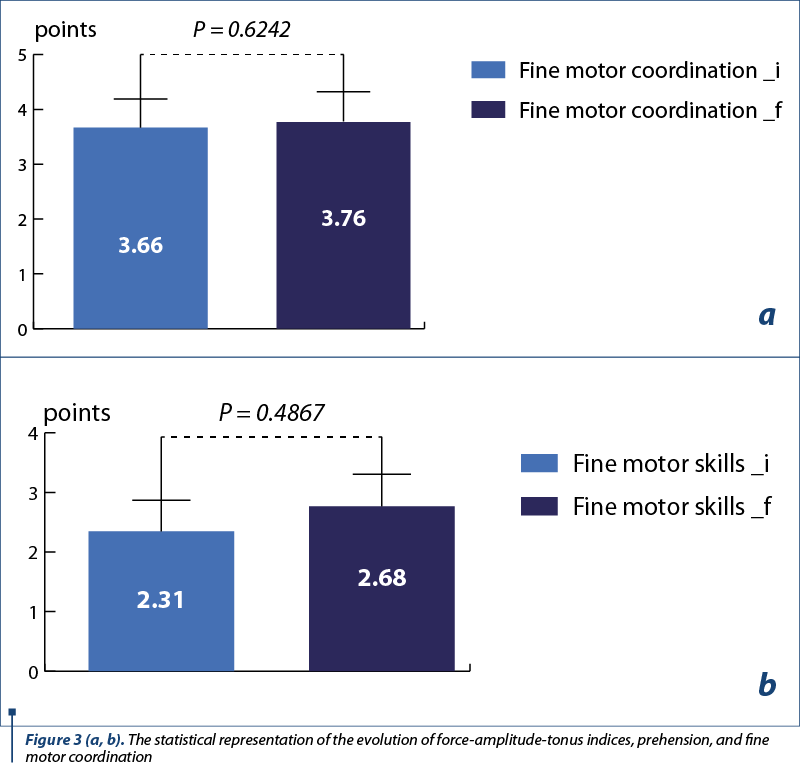Occupational therapy tries to develop the quality of life of any person whose functional ability is limited, this goal being achieved by greater independence in any field of occupational behaviour. Materials and method. This research is a case study series of five children with special educational needs (Down syndrome, Pierre Robin syndrome, West syndrome, severe multicystic encephalomyelitis, craniocerebral trauma), monitored at the “Speranţa” Resource and Assistance Center in Timişoara. The subjects benefited from occupational therapy services during the 2017-2018 school year at the occupational ergotherapy unit once a week. Parental counselling was provided in addition to individual and multidisciplinary meetings. The elected subjects (three boys and two girls) also participate in other therapies at the “Speranţa” Resource and Assistance Center (CRA), being included in mass education, in integration classes. The initial and final evaluation with the “Speranţa” CRA fact sheet focused on: fine motor precision, coordination, strength, amplitude, tone, manual skills, and perceptual-motor structures (shape, colour, body schematics, spatial and temporal orientation). Results. The fine motor mobility of pupils with special educational needs was improved, but not statistically significant, after the intervention through the customized occupational therapy program. Thus, preference, grip (23.69±10.99 to 44.13±15.53; p=0.002), fine motor coordination (3.66±0.29 to 3.76±0.32; p=0.6242), strength, amplitude, muscle tone (3.49±0.23 to 3.79±0.18; p=0.0557), and hand skills (2.31±0.85 to 2.68±0.74; p=0.4867) improved in all subjects. Conclusions. Occupational therapy must be included in the management program of children with special educational needs due to its efficiency in promoting motor control through diverse and attractive activities. A consistent occupational therapy tailored to the needs of the child is probably the most important factor in the development of the fine motor skills and the motor perceptual structure of the child with special needs.
Îmbunătăţirea motricităţii fine la copiii cu nevoi speciale utilizând terapia ocupaţională
Improving fine motor skills in children with special educational needs by occupational therapy
First published: 19 martie 2020
Editorial Group: MEDICHUB MEDIA
DOI: 10.26416/Pedi.57.1.2020.3064
Abstract
Rezumat
Terapia ocupaţională încearcă să dezvolte calitatea vieţii oricărei persoane a cărei capacitate funcţională este limitată, acest obiectiv fiind atins printr-o mai mare independenţă în orice domeniu de comportament. Materiale şi metodă. Cercetarea este bazată pe un studiu de caz a cinci copii cu nevoi educaţionale speciale (sindrom Down, sindrom Pierre Robin, sindromul West, encefalomielită multichistică severă, traumatisme cranio-cerebrale), care desfăşoară terapii în cadrul Centrului de Resurse şi Asistenţă Educaţională (CRAE) „Speranţa“ din Timişoara. Subiecţii au beneficiat de servicii de terapie ocupaţională pe parcursul anului şcolar 2017-2018 la Unitatea de ergoterapie ocupaţională o dată pe săptămână. Consilierea parentală a fost furnizată în cadrul reuniunilor multidisciplinare. Subiecţii aleşi (trei băieţi şi două fete) participă, de asemenea, la alte terapii în Centrul „Speranţa“, fiind incluşi în învăţământul de masă, în clasele de integrare. Evaluarea iniţială şi finală cu ajutorul Fişei de evaluare CRAE „Speranţa“ se concentrează pe: precizie, motricitate fină, coordonare, rezistenţă, amplitudine, tonus, abilităţi manuale şi structuri perceptiv-motrice (formă, culoare, schema corpului, orientarea spaţială şi orientarea temporală). Rezultate. Motricitatea fină a elevilor cu nevoi educaţionale speciale este îmbunătăţită, însă nu semnificativ statistic, prin programul de terapie ocupaţională personalizată. Putem observa îmbunătăţiri la toţi subiecţii: prinderea (23,69±10,99 la 44,13±15,53, p=0,002), coordonarea motorie fină (3,66±0,29 la 3,76±0,32, p=0,6242), puterea, amplitudinea, tonusul muscular (3,49±0,23 la 3,79±0,18, p=0,0557) şi abilităţi manuale (2,31±0,85 la 2,68±0,74, p=0,4867). Concluzii. Terapia ocupaţională trebuie să fie inclusă în programul de management al copiilor cu nevoi educaţionale speciale datorită eficienţei sale în promovarea controlului motor prin activităţi diverse şi atractive. O terapie ocupaţională consistentă adaptată la nevoile copilului este, probabil, cel mai important factor în dezvoltarea motricităţii fine şi a structurii perceptive-motorie a copilului cu nevoi speciale.
Introduction
Occupational therapy tries to develop the quality of life of any person whose functional ability is limited(1), this goal being achieved by greater independence(2) in any field of occupational behaviour(3). In the past, most of the deficient patients were condemned to unchanged disability(4), but kinesitherapy(5) and occupational therapy(6-8) developed their autonomy(2,5). The improvement of muscle tone associates better ossification(9,10), increased muscle capacity(4,11,12), liver function improvement(13,14) and immunity upgrading(15,16), in children with chronic pathologies(10,17) being demonstrated the risks of associated fractures(9) and functional impotence or immunodeficiency(16), with subsequent respiratory and systemic infections(17). The children with special educational needs are exposed to infectious complications(18) due to increased susceptibility to infections during childhood(10) and to complications associated with medication, which requires a cautious approach(19). Like other patients with cystic fibrosis who describe hepatic(13), bone(9) or vitamin and mineral deficiencies, the patients with Down syndrome might have the same complications(20). Previously, people with disabilities were happy to “survive”, but today they want to “live”.



Materials and method
This research is a case study series of five children with special educational needs (Down syndrome, Pierre Robin syndrome, West syndrome, severe multicystic encephalomyelitis, craniocerebral trauma), monitored at the “Speranţa” Resource and Assistance Center (CRA) in Timişoara. The patients’ parents signed the inform consent and the inclusion into the study. Subjects benefited from occupational therapy services during the 2017-2018 school year at the occupational ergotherapy unit once a week. Parental counselling was provided in addition to individually and in multidisciplinary meetings. The elected subjects (three boys and two girls) also participate in other therapies at “Speranţa” CRA, being included in mass education, in integration classes. The age of the subjects varied from 10 to 17 years old. The research stages were: obtaining the informed consent, initial testing (September-October 2017), intervention (October 2017 – May 2018) and final testing (June 2018). The initial and final evaluation with the “Speranţa” CRA fact sheet focused on: fine motor precision, coordination, strength, amplitude, tone, manual skills and perceptual-motor structures (shape, colour, body schematics, spatial and temporal orientation).
Results and discussion
The fine mobility of pupils with special educational needs is improved (Figure 1), but not statistically significant, after the intervention through the customized occupational therapy program. Thus, preference, grip (23.69±10.99 to 44.13±15.53; p=0.002), fine motor coordination (3.66±0.29 to 3.76±0.32; p=0.6242), strength, amplitude, muscle tone (3.49±0.23 to 3.79±0.18; p=0.0557), and hand skills (2.31±0.85 to 2.68±0.74; p=0.4867) improved in all subjects (Figure 2).
Regarding fine motor coordination, all five subjects have evolved following the application of the occupational therapy program. Two subjects had a good progression and three subjects had a satisfactory evolution according to the ergotherapy sheet.
As far as prehension is concerned, all five subjects evolved statistically, following the application of the occupational therapy program – four of them obtained the mark at the end of the school year. One subject achieved the expected maximum performance, and another subject came close to the maximum score. In terms of strength, amplitude and muscle tone, all subjects had a satisfactory performance during the school year, two of them reaching the maximum score – the qualification was very good, and the other three achieved the qualification well. The testing of the manual skills showed that all subjects made progress during the school year. Thus, a patient had a good evolution, and four subjects developed satisfactorily. Regarding orientation, organization and time structure, all subjects progressed throughout the school year; a patient had a good evolution and four patients had a satisfactory evolution (Figure 3 a, b).
The perceptual-motor structures of form and colour, body schematics, orientation, organization, spatial structure, and temporal organization and structure have improved, but have evolved less than that of fine motor skills, because all subjects exhibited intellectual development disorder, and the development of perceptual-motor structures is closely related to the cognitive ability of the patient.
Conclusions
Occupational therapy must be included in the management program of children with special educational needs, due to its efficiency in promoting motor control through diverse and attractive activities. A consistent occupational therapy tailored to the needs of the child is probably the most important factor in the development of the fine motor skills and the motor perceptual structure of the child with special needs. Ergotherapy is particularly important, being the only process that combines motor skills, integrated functions of the nervous system, mental attention, problem solving and emotional satisfaction in defined tasks. Therefore, our children will live better and longer, in a healthier and happier way.
Funding: This research received no external funding.
Acknowledgments: We acknowledge the patients and their families support given with the study, and colleagues from the ambulatory setting for their help.
Conflicts of interests: The authors declare no conflict of interests.
Bibliografie
- Popovici DV. Terapia ocupaţională pentru persoanele cu cerinţe speciale. Editura Pro Humanitate, Bucureşti, 2004.
- Popovici DV. Terapia ocupaţională pentru persoanele cu deficienţe. Editura Muntenia, Constanţa, 2004.
- Musu I, Taflan A. Terapia educaţională integrată. Editura Pro Humanitate, Bucureşti, 1997.
- Popescu A. Terapia ocupaţională şi ergoterapia. Editura Cerna Bucureşti, 1993.
- Bălteanu V. Metode kinetologice. Terapia ocupaţională şi ergoterapia. Editura Cermi, Iaşi, 2004.
- Pritcan V, Chihai J. Terapie ocupaţională şi reabilitare psihosocială. Suport de curs. Bălţi, 2008.
- Mârza-Dănilă D. Ergoterapie Note de curs. Universitatea Bacău, 1997.
- Ciocoi-Pop DR. Terapie ocupaţională. Curs. Universitatea „Babeş-Bolyai” Cluj-Napoca, 2009.
- Ciuca IM, Pop LL, Rogobete AF, Onet DI, Guţă-Almăjan B, Popa Z, Horhat FG. Genetic expression in cystic fibrosis related bone disease. An observational, transversal, cross-sectional study. Clin Lab. 2016 Sep 1; 62(9):1725-1730.
- Pettoello-Mantovani M, Ehrich J, Sacco M, Ferrara P, Giardino I, Pop TL. Food Insecurity and Children’s Rights to Adequate Nutrition in Europe. J Pediatr. 2018 Jul; 198:329-330.
- Huţanu D, Popescu R, Ştefănescu H, Pirtea L, Candea A, Sarau C, Boruga O, Mehdi L, Ciuca I, Tănăsescu S. The molecular genetic expression as a novel biomarker in the evaluation and monitoring of patients with osteosarcoma-subtype bone cancer disease. Biochem Genet. 2017; 55(4):291–299.
- Mihăilă DE, Potecă TD, Poteca AG, Matei C, Ciuca I, Tampa M. The use of argon laser in medical treatment. Rev Chim. 2014; 65(3):369-371.
- Ciuca IM, Pop L, Tămaş L, Tăban S. Cystic fibrosis liver disease-from diagnostic to risk factors. Rom J Morphol Embryol. 2014; 55:91–95.
- Ciucă IM, Pop L, Ranetti AE, et al. Ursodeoxycholic acid effects on cystic fibrosis liver disease. Farmacia. 2015; 63(4):543-547.
- Ciuca, IM, Popescu, IM, Lupea, AX et al. Mannan – binding lectine serum level dosing method. Rev Chim. 2014; 65(1):123-125.
- Anghel I, Grumezescu AM, Holban AM, et al. Improved activity of aminoglycosides entrapped in silica networks against microbial strains isolated from otolaryngological infections. Farmacia. 2013; 62(1):69-78.
- David VL, Ercisli MF, Rogobete AF, Boia ES, Horhat R, Niţu R, Tătaru C. Early Prediction of Sepsis Incidence in Critically Ill Patients Using Specific Genetic Polymorphisms. Biochemical Genetics. 2017; 55(3):193-203.
- Pop TL, Ştefănescu A, Samaşca G, Miu N. Clinical significance of the antinuclear antibodies in chronic viral hepatitis B in children. Clin Lab. 2014; 60(6):931-9.
- Ştefănescu AC, Pop TL, Stefanescu H, Miu N. Transient elastography of the liver in children with Wilson’s disease: Preliminary results. J Clin Ultrasound. 2016 Feb; 44(2):65-71. doi: 10.1002/jcu.22281
- Ugazio AG, Maccario R, Notarangelo LD, Burgio GR. Immunology of Down syndrome: A review. Am J Med Genet. 1990; 37: 204-212. doi:10.1002/ajmg.1320370742
Articole din ediţiile anterioare
Distrofia musculară progresivă - update
Distrofia musculară progresivă Duchenne a fost descrisă de Guillaume Duchenne de Boulogne în 1868. Este forma clinică cea mai comună la copil, inci...
Spirometric assessment in asthma in children
Astmul este o boală importantă, atât la adulţi, cât şi la copii, care conduce frecvent la implicaţii financiare şi de sănătate semnificative la...
Purpura fulminans, modalitate de debut clinic în sindromul inflamator multisistemic la copil (MIS-C)
Încă de la începutul anului 2020, boala coronavirus 2019 (COVID-19) a reprezentat o mare problemă de sănătate pe întreg globul, mai ales la adulţi...
Perspective în hepatita cronică virală C la copil
Virusul hepatitic C a fost descoperit de către Q.L. Choo (1988) şi M. Houghton (1989) de la laboratoarele Emeryville, California, în colaborare cu ...